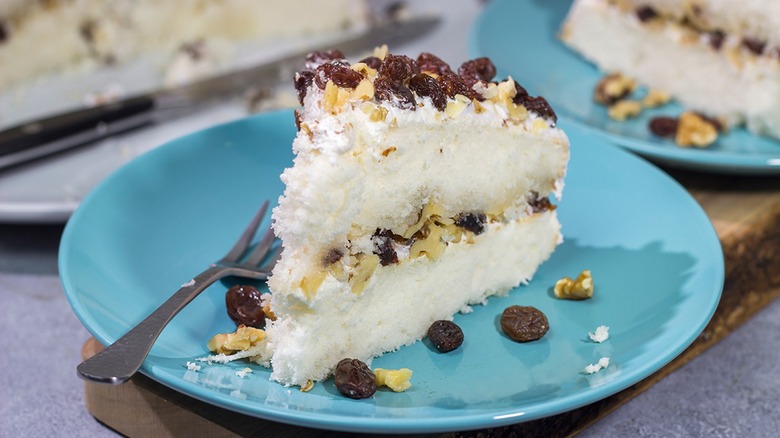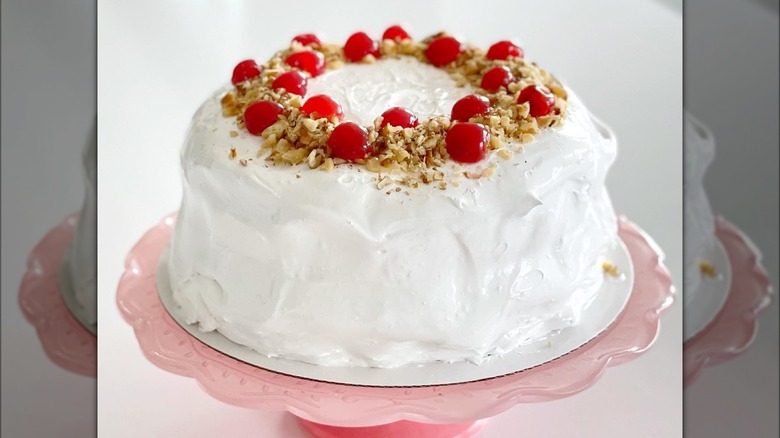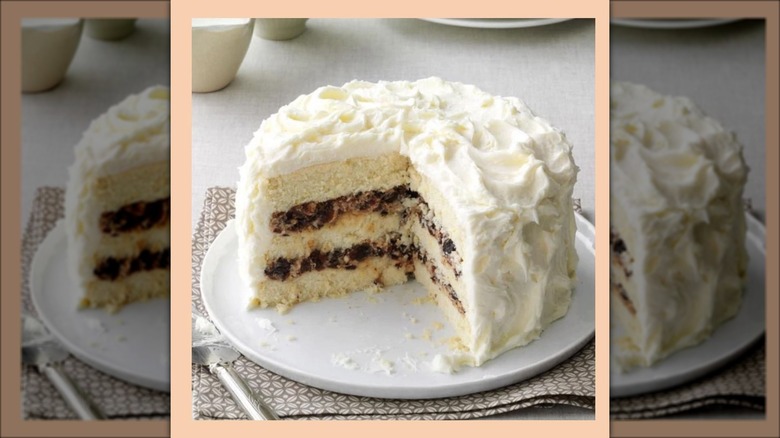What Is A Lady Baltimore Cake And How Did It Get Its Name?
There are quite a few different cakes whose origins lie in the southern United States. The Pig Pickin' Cake, made from a yellow cake mix, oranges, and a fluffy, vanilla-pineapple frosting, first found its fame in North Carolina. Coca-Cola chocolate cake was first enjoyed at potlucks and parties in southern states, before finding fame nationwide thanks to its adoption onto the Cracker Barrel menu.
Although it shares part of its name with a Maryland city, the Lady Baltimore cake's roots are actually further south than the name implies. The sweet and fruity southern staple was popularized in the early 1900s, and it combines layers of fluffy, white cake with a filling of walnuts, dried fruits, and a little bit of alcohol in with the meringue frosting. The cake was stable enough to stand up to hot summer days, making it ideal for enjoyment by those in the south — which is where its invention is credited.
What are the components of the cake?
So, what exactly makes up a Lady Baltimore cake? The cake itself is a fluffy, airy cake. Its bright white color is preserved thanks to the use of only egg whites whipped into stiff peaks, then folded into the batter. After the cake layers have baked and cooled, they should be sliced evenly to create four separate layers of cake.
Between each of those layers is a fruity, nutty filling. Raisins and dates are boiled in rum to absorb the liquor, then chopped toasted walnuts are added to the mix. If you aren't a fan of raisins and rum, other dried fruits and spirits are acceptable substitutes. The fruits are then mixed into a bowl of whipped meringue frosting, which is spread between the cake layers.
Once the cake has been assembled with alternating layers of cake and frosting filling, the entire thing is covered with more frosting, and optionally decorated with some more fruit and nuts on top.
How did the cake get its name?
Despite its name, the cake doesn't come from Baltimore. Its invention actually took place in Charleston, South Carolina. The cake's popularity sprouted from it being a fictional dessert, discussed in the book "Lady Baltimore" by author Owen Wister.
The novel was published in 1906, and tells the tale of a groom who goes to order a Lady Baltimore wedding cake. The cake plays an integral role in the story, as the groom has cold feet regarding his fiancée. He ultimately calls off the wedding to instead marry the bakery's cashier — canceling his order for the Lady Baltimore cake in the process.
The credit for the cake that inspired Wister is somewhat disputed. The cake was most likely baked at The Women's Exchange tearoom in Charleston. There, it was likely created by its managers, sisters Florrie and Nina Ottolengui, though others credit Alicia Rhett Mayberry with the actual baking of the dessert.
It's also unclear if the real cake inspiration also bore the Lady Baltimore moniker when it was served to Wister. However, the term "Lady Baltimore" was, at the time, associated with high-class products. The cake may have been dubbed so in order to make diners feel a little fancier. Whatever the cake's real origin, its recipe has prevailed for over a century, thanks to its unique flavors and textures.


